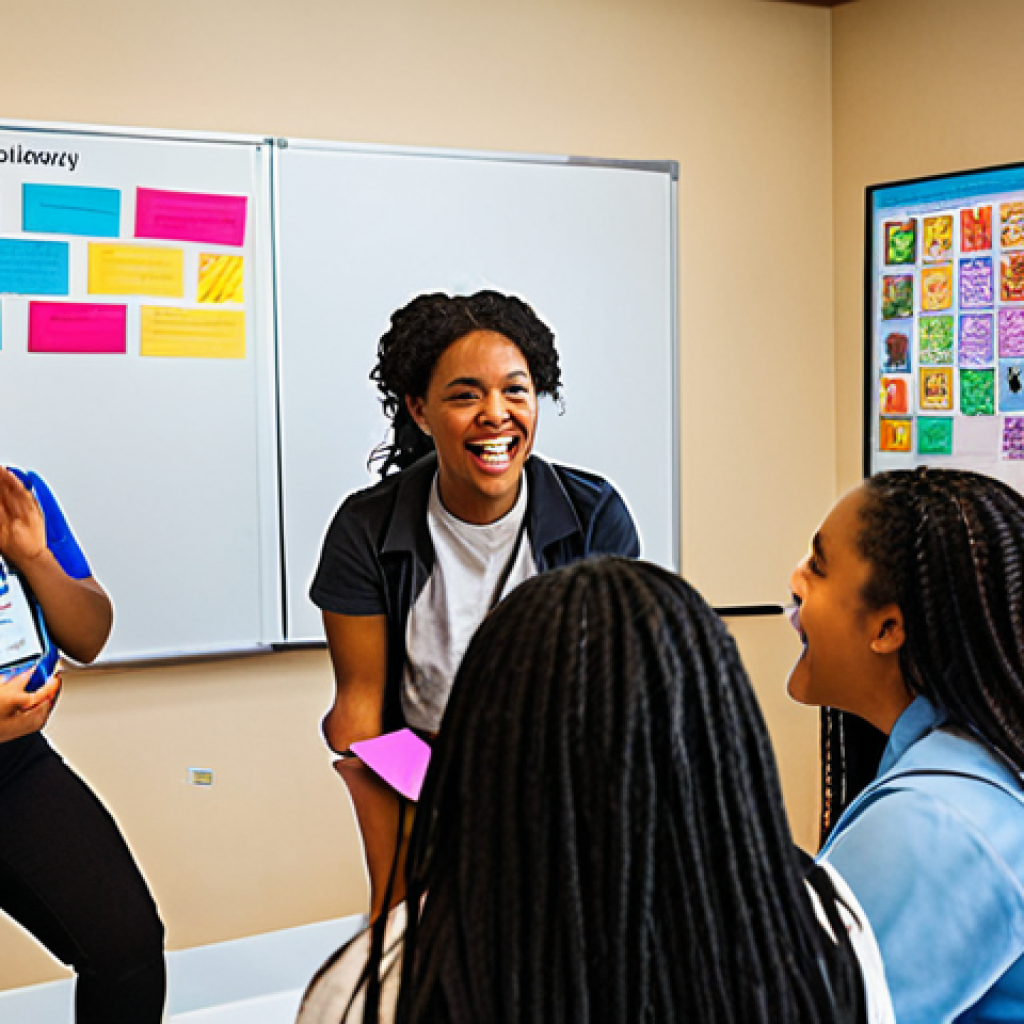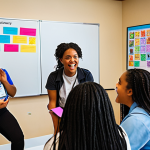Being a youth worker is more than just a job; it’s a calling. It’s about constantly growing and adapting to the ever-changing needs of young people. I’ve found that complacency is the enemy – the moment you stop learning, you start to fall behind.
This means actively seeking out opportunities to enhance your skills and knowledge. From understanding the latest mental health trends impacting teens to mastering new communication strategies, the journey of self-improvement is a continuous one.
The more equipped we are, the better we can empower the next generation to thrive in an increasingly complex world. Also, with the rise of AI and technology reshaping youth culture, staying updated on these trends is paramount.
I’ll guide you through some practical ways to boost your skills and stay relevant. Let’s delve into the details in the article below!
Embracing Continuous Learning Through Workshops and Conferences

One of the most impactful ways I’ve discovered to level up as a youth worker is through workshops and conferences. It’s more than just ticking off professional development hours; it’s about immersing yourself in new ideas, networking with peers, and reigniting your passion. I remember attending a workshop on trauma-informed care a few years back, and it completely shifted my approach to working with young people. The techniques I learned there not only helped me understand the root causes of certain behaviors but also equipped me with practical strategies to support youth dealing with challenging situations. It made me realize how crucial it is to stay updated on the latest research and best practices in the field.
Finding the Right Fit
The key here is to be selective. Not all workshops are created equal. Consider your specific needs and areas where you feel you could improve. For instance, if you’re struggling with conflict resolution within your youth group, seek out a workshop that focuses on mediation and de-escalation techniques. Look for reputable organizations or trainers with proven track records. Check out the speaker bios and program outlines beforehand to ensure they align with your goals. I usually read reviews or ask for recommendations from colleagues before committing to anything.
Making the Most of the Experience
Attending is only half the battle. To truly maximize the benefits, be an active participant. Engage in discussions, ask questions, and share your own experiences. Take detailed notes – I often find myself referring back to my workshop notebooks months later. And don’t be afraid to step outside your comfort zone and network with other attendees. You never know what valuable connections you might make. After the workshop, take some time to reflect on what you’ve learned and how you can apply it to your work. Maybe create an action plan with specific steps you can take to implement new strategies.
Sharing Knowledge with Colleagues
The impact of a workshop extends beyond the individual attendee. Share your newfound knowledge with your team or organization. Perhaps you can lead a training session or create a resource guide based on what you’ve learned. This not only reinforces your own understanding but also benefits your colleagues and the young people you serve. Plus, it demonstrates your commitment to professional growth and collaboration.
Mastering the Art of Digital Communication
In today’s digital age, effective online communication is non-negotiable for youth workers. Young people are constantly connected, and we need to meet them where they are – online. This means understanding various social media platforms, crafting engaging content, and being mindful of online safety. I’ve seen firsthand how a well-executed social media campaign can boost youth engagement and create a sense of community. But it also means being aware of the potential pitfalls, like cyberbullying and online privacy concerns.
Choosing the Right Platforms
Not every platform is created equal, and not every platform is right for every youth group. Consider your target audience and the types of content that resonate with them. For example, Instagram might be ideal for sharing photos and videos of activities, while Twitter could be used for quick updates and announcements. TikTok is amazing for short, engaging videos. Experiment with different platforms and track your results to see what works best. Don’t spread yourself too thin – it’s better to focus on a few platforms and do them well than to try to be everywhere at once.
Crafting Engaging Content
Simply having a presence online isn’t enough; you need to create content that grabs attention and sparks interaction. Think about what matters to young people – their interests, concerns, and aspirations. Use storytelling, humor, and visuals to make your content more appealing. Encourage participation by asking questions, running polls, and hosting online contests. Be authentic and genuine – young people can spot a fake a mile away. I always try to create content that is informative, entertaining, and relevant to their lives.
Promoting Online Safety and Responsibility
With the benefits of digital communication come responsibilities. Teach young people about online safety, privacy, and ethical behavior. Discuss the dangers of cyberbullying, online predators, and sharing personal information. Model responsible online behavior yourself, and create clear guidelines for online interactions within your youth group. Partner with parents or guardians to reinforce these messages at home. By fostering a culture of online safety and responsibility, we can empower young people to navigate the digital world safely and confidently.
Building Strong Relationships Through Mentorship Training
At its core, youth work is about building relationships. And one of the most powerful ways to foster those connections is through mentorship. But effective mentorship requires more than just pairing a young person with an adult; it requires training, support, and ongoing reflection. I’ve seen firsthand how a well-structured mentorship program can transform the lives of both mentors and mentees. It provides young people with guidance, support, and a sense of belonging, while empowering adults to make a meaningful difference in their community.
Understanding the Principles of Effective Mentorship
Mentorship isn’t just about being a friend; it’s about providing structured guidance and support. Mentors need to understand the principles of effective communication, active listening, and goal setting. They need to be able to build trust, set boundaries, and address challenging situations. Mentorship training should cover these topics, as well as the specific needs and challenges faced by young people in your community. Also, mentors should be aware of their role as a trusted adult and the ethical boundaries that come with it.
Providing Ongoing Support and Supervision
Mentorship is a journey, not a destination. Mentors need ongoing support and supervision to ensure they are fulfilling their roles effectively. This could include regular check-ins with program staff, peer support groups, or additional training sessions. Provide mentors with resources and tools to help them navigate challenging situations, such as conflict resolution strategies or tips for addressing mental health concerns. Regularly assess the progress of the mentorship relationships and make adjustments as needed.
Measuring the Impact of Mentorship
How do you know if your mentorship program is making a difference? It’s important to establish clear goals and metrics for success. This could include tracking improvements in academic performance, attendance rates, or behavioral outcomes. Collect feedback from mentors, mentees, and parents to get a comprehensive picture of the program’s impact. Use this data to make improvements and demonstrate the value of your mentorship program to stakeholders. When I was doing youth work, measuring impact gave me and the team a great sense of accomplishment.
Prioritizing Self-Care and Preventing Burnout
Youth work can be incredibly rewarding, but it can also be demanding and emotionally draining. It’s easy to get caught up in the needs of others and forget about your own well-being. But if you’re not taking care of yourself, you can’t effectively care for others. Burnout is a real risk in this field, and it can have serious consequences for both you and the young people you serve. That’s why self-care is not a luxury; it’s a necessity.
Recognizing the Signs of Burnout
The first step in preventing burnout is to recognize the warning signs. These can include fatigue, irritability, difficulty concentrating, feelings of hopelessness, and a loss of interest in your work. You might also experience physical symptoms like headaches, stomach problems, or sleep disturbances. Pay attention to your body and your emotions, and don’t ignore these red flags. The earlier you recognize the signs of burnout, the easier it will be to address them.
Implementing Practical Self-Care Strategies
Self-care doesn’t have to be expensive or time-consuming. It can be as simple as taking a few minutes each day to meditate, go for a walk, read a book, or listen to music. Make time for activities you enjoy, whether it’s spending time with loved ones, pursuing a hobby, or volunteering in your community. Set boundaries with your work – don’t check emails or answer phone calls after hours. And don’t be afraid to ask for help when you need it. Talking to a therapist or counselor can provide valuable support and guidance.
Creating a Supportive Work Environment
Your workplace should be a source of support, not stress. Encourage open communication and collaboration among your colleagues. Create opportunities for team-building activities and social events. Promote a culture of appreciation and recognition – acknowledge the hard work and dedication of your team members. And ensure that everyone has access to resources and support services, such as employee assistance programs or mental health counseling.
Understanding and Addressing Mental Health Challenges
Mental health challenges are increasingly prevalent among young people. As youth workers, we need to be equipped to recognize the signs of mental health issues and provide appropriate support. This means understanding common mental health conditions like anxiety, depression, and eating disorders, as well as knowing how to connect young people with professional help when needed. I’ve had several situations where I was the first person to notice a young person was struggling with something. That’s why ongoing training is so important.
Recognizing the Signs and Symptoms
It’s not always easy to tell when a young person is struggling with a mental health issue. They may try to hide their symptoms or may not even realize that something is wrong. Look for changes in behavior, mood, or performance. Are they withdrawing from social activities, experiencing persistent sadness or irritability, or having difficulty concentrating? Are they expressing feelings of hopelessness, worthlessness, or self-harm? If you notice any of these signs, it’s important to take them seriously and reach out to the young person.
Providing a Safe and Supportive Environment
Creating a safe and supportive environment is crucial for young people who are struggling with mental health issues. Let them know that they are not alone and that it’s okay to ask for help. Listen to their concerns without judgment, and validate their feelings. Offer encouragement and support, and help them connect with resources and services. Be patient and understanding, and remember that recovery is a process. As a youth worker, you are their advocate.
Connecting Young People with Professional Help
While you can provide support and encouragement, you are not a mental health professional. It’s important to know when to refer a young person to professional help. This could include a therapist, counselor, psychiatrist, or other mental health specialist. Have a list of local resources readily available, and be prepared to help the young person and their family navigate the referral process. Follow up with the young person to see how they are doing and offer ongoing support.
Leveraging Technology for Enhanced Program Delivery
Technology has revolutionized the way we live, work, and interact. And it can also be a powerful tool for enhancing program delivery in youth work. From online learning platforms to virtual reality experiences, technology can help us reach more young people, engage them in new and innovative ways, and personalize their learning experiences. I’ve been impressed with how technology can provide access to resources that were once out of reach.
Exploring Online Learning Platforms
Online learning platforms offer a wealth of opportunities for youth development. They can provide access to educational resources, skill-building workshops, and mentorship programs. Online learning can be especially beneficial for young people who live in remote areas or who have limited access to traditional programs. Look for platforms that are interactive, engaging, and tailored to the needs of young people. Make sure the content is relevant, up-to-date, and aligned with your program goals.
Utilizing Social Media for Engagement and Outreach
Social media is a powerful tool for engaging young people and promoting your programs. Use social media to share information, connect with participants, and build a sense of community. Create engaging content that is relevant to young people’s interests, and encourage them to participate in discussions and activities. Be mindful of online safety and privacy, and ensure that your social media activities are consistent with your organization’s policies.
Implementing Data-Driven Decision Making
Technology can also help us collect and analyze data to improve our program delivery. Use data to track participant progress, identify areas for improvement, and measure the impact of your programs. Implement data-driven decision making to ensure that your programs are effective, efficient, and aligned with the needs of young people. Use data to demonstrate the value of your programs to stakeholders and secure funding for future initiatives.
| Skill Area | Training Methods | Benefits for Youth Workers | Resources |
|---|---|---|---|
| Digital Communication | Webinars, online courses, social media workshops | Improved outreach, enhanced engagement, better online safety | Hootsuite Academy, Google Digital Garage |
| Mental Health Awareness | Certification programs, seminars, peer support groups | Early identification, appropriate support, reduced stigma | Mental Health First Aid, National Council for Behavioral Health |
| Mentorship | Workshops, role-playing, mentorship handbooks | Stronger relationships, increased guidance, better outcomes for youth | MENTOR, Big Brothers Big Sisters |
| Self-Care | Mindfulness training, stress management workshops, counseling services | Reduced burnout, improved well-being, better ability to support youth | Headspace, Calm |
Cultivating Cultural Competence and Inclusion
Our communities are becoming increasingly diverse, and it’s essential for youth workers to be culturally competent and inclusive. This means understanding and respecting the different cultures, backgrounds, and identities of the young people we serve. It also means creating programs and environments that are welcoming, equitable, and accessible to all. I’ve learned so much from the young people I work with just by being open and listening to their experiences.
Understanding Cultural Differences
Cultural competence starts with understanding and appreciating cultural differences. This means learning about the values, beliefs, and customs of different cultures, as well as being aware of your own biases and assumptions. Attend cultural events, read books and articles, and engage in conversations with people from different backgrounds. Be open to learning and challenging your own perspectives.
Creating Inclusive Programs and Environments
Inclusion goes beyond simply being tolerant of differences; it means actively creating programs and environments that are welcoming and accessible to all. Ensure that your programs are culturally relevant and responsive to the needs of diverse populations. Use inclusive language and images in your communications, and provide accommodations for people with disabilities. Create opportunities for young people from different backgrounds to interact and learn from each other.
Addressing Issues of Equity and Justice
Cultural competence also involves addressing issues of equity and justice. Recognize that some young people face systemic barriers and disadvantages due to their race, ethnicity, gender, sexual orientation, or other identities. Advocate for policies and practices that promote equity and opportunity for all young people. Be an ally for marginalized groups, and challenge discrimination and prejudice whenever you see it.
In Closing
As youth workers, our journey of learning and growth never truly ends. By continually embracing new skills, staying informed about emerging trends, and prioritizing our own well-being, we can create a positive impact on the lives of young people. Let’s commit to ongoing professional development, fostering strong relationships, and creating a brighter future for the next generation. It’s a challenging but incredibly rewarding path.
Useful Tips to Know
1. Explore free online courses on platforms like Coursera or edX to enhance your skills in areas like digital communication or mental health.
2. Attend local workshops or conferences offered by youth organizations or community centers to network with peers and learn about best practices.
3. Utilize social media platforms like LinkedIn to connect with other youth workers and share resources and ideas.
4. Seek mentorship from experienced youth workers or professionals in related fields to gain guidance and support.
5. Prioritize self-care activities like exercise, meditation, or spending time in nature to prevent burnout and maintain your well-being.
Key Takeaways
Investing in continuous learning through workshops and conferences keeps you updated and passionate.
Mastering digital communication allows you to connect with young people where they are and promote online safety.
Building strong relationships through mentorship training provides guidance and support to both mentors and mentees.
Prioritizing self-care is essential for preventing burnout and ensuring you can effectively support others.
Understanding and addressing mental health challenges allows you to provide appropriate support and connect young people with professional help.
Leveraging technology enhances program delivery and allows you to reach more young people in innovative ways.
Cultivating cultural competence and inclusion creates welcoming and equitable programs for all young people.
Frequently Asked Questions (FAQ) 📖
Q: Why is continuous learning so important for youth workers, especially now?
A: Honestly, if you’re not learning, you’re lagging! The youth scene is a whirlwind of change. Take TikTok trends, for example.
One minute they’re all about some dance craze, the next it’s a new challenge. More seriously, young people face mental health challenges, social pressures, and online safety concerns at a rate that seems much faster than when I was a teen.
If we’re not up-to-date on these realities, how can we even begin to support them effectively? It’s like trying to navigate a city with an outdated map – you’ll get lost fast.
We need to know what’s impacting them, what language they use, and what their struggles are to truly connect and guide them.
Q: What specific skills or knowledge areas should youth workers prioritize improving?
A: From my experience, it’s a mix of the foundational and the emerging. Solid communication skills are a must, of course. I mean, really listening – not just hearing – is the key.
Knowing how to facilitate open and honest conversations is something I always work on. But then, you’ve got to dive into tech literacy. It’s not just about knowing how to use Instagram, it’s understanding the potential impact of social media on a young person’s self-esteem and online safety.
Finally, let’s not forget about mental health awareness. Knowing the signs of anxiety, depression, or even just dealing with stress in teens is so important.
I’ve attended workshops on crisis intervention and it’s really helped me learn how to calmly approach these sensitive situations.
Q: How can youth workers practically incorporate these learning opportunities into their already busy schedules?
A: That’s the million-dollar question, isn’t it? Honestly, it’s about finding creative ways to weave it into your routine. Podcasts are my new best friend!
I listen to youth development podcasts during my commute, or while I’m prepping materials. Also, online courses. Many universities and organizations offer flexible online programs that fit into even the busiest schedule.
Think short modules and webinars. And honestly, sometimes the best learning comes from sharing with other youth workers. I participate in a monthly peer support group, where we discuss challenges, and resources, and swap strategies.
Just a small time commitment, but it can make a huge difference!
📚 References
Wikipedia Encyclopedia
구글 검색 결과
구글 검색 결과
구글 검색 결과
구글 검색 결과
구글 검색 결과






